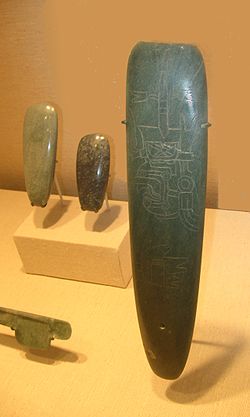| This article needs additional citations for verification. Please help improve this article by adding citations to reliable sources. Unsourced material may be challenged and removed. Find sources: "Celt" tool – news · newspapers · books · scholar · JSTOR (April 2016) (Learn how and when to remove this message) |


In archaeology, a celt /ˈsɛlt/ is a long, thin, prehistoric, stone or bronze tool similar to an adze, hoe, or axe.
A shoe-last celt was a polished stone tool used during the early European Neolithic for felling trees and woodworking.
Etymology
The term "celt" seems to have come about from a copyist's error in many medieval manuscript copies of Job 19:24 in the Latin Vulgate Bible, which became enshrined in the authoritative Sixto-Clementine printed edition of 1592. Where all earlier versions (the Codex Amiatinus, for example) have vel certe (the Latin for 'but surely'), the Sixto-Clementine has vel celte. The Hebrew has לעד (lā‘aḏ) at this point, which means 'forever'. The editors of the Oxford English Dictionary " to the belief that celtis was a phantom word", simply a misspelling of certe. However, some scholars over the years have treated celtis as a real Latin word.
From the context of Job 19:24 ("Oh, that my words were inscribed with an iron tool on lead, or engraved in rock forever!"), the Latin word celte was assumed to be some kind of ancient chisel. Eighteenth-century antiquarians, such as Lorenz Beger [de; fr], adopted the word for the stone and bronze tools they were finding at prehistoric sites; the OED suggests that a "fancied etymological connexion" with the prehistoric Celts assisted its passage into common use.
See also
- Hapax legomenon – Word that only appears once in a given text or record
- Palstave – European Bronze Age axe
- Rattleback – Semi-ellipsoidal spinning top
References
- Edgar C. S. Gibson (1899). Walter Lock (ed.). The Book of Job (Westminster Commentaries). London: Methuen & Co. Retrieved 2020-09-27.
- ^ M. L. W. Laistner (1925-01-01). "Floscvli Philoxenei ". The Classical Quarterly. 19 (3/4): 192–195. doi:10.1017/S0009838800015846. JSTOR 636281.
- ^ Oxford English Dictionary entry for "CELT (2)," quoted in Martin Burns. "Re: the word Celt". CELTIC-L, The Celtic Culture List. Archived from the original on 2011-07-17.
External links
- Chisholm, Hugh, ed. (1911). "Celt (tool)" . Encyclopædia Britannica (11th ed.). Cambridge University Press.